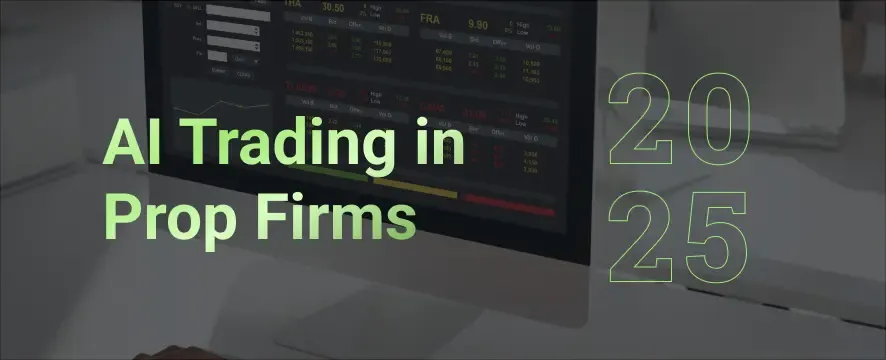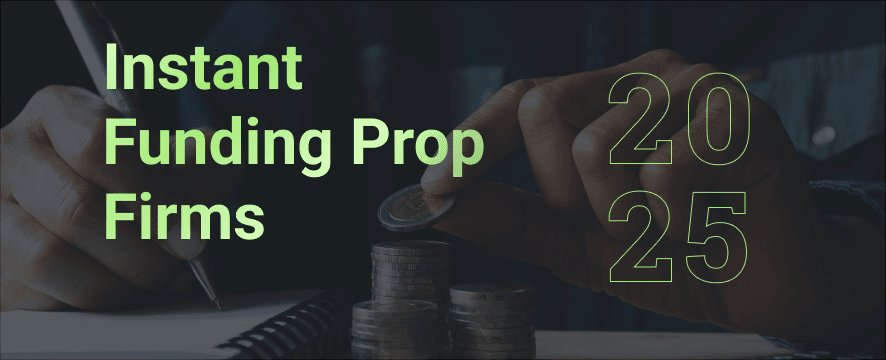
18 min read
Funded Trading Accounts Explained: Types, Benefits & How to Get One
A funded trading account gives you access to a firm’s capital to trade, share profits, and reduce personal risk.
13 min read
Share
To become a funded trader in 2025, you must pass prop firm challenges by mastering strategy, risk control, and trading rules.

Funded firms enable traders to access a prop firm's capital and scale their trading ambitions much more effectively. However, traders will need to pass an evaluation phase and maintain strict adherence to the firm's trading rules to remain a funded trader.
Back in the day, trading firms were radically different from what it is today. It was more of a niche activity, reserved for banks and institutions.
For many years, traders who were really good at their craft would find their earning potential limited by the amount of capital they had, and would be unable to easily scale their accounts. But the rise of funded trading accounts has made it much more viable for retail traders to access larger sums of capital and increased buying power to trade with.
And the interest in prop firms is skyrocketing. The term “prop firm” saw a mind-blowing surge in interest—now crossing 49,500 global monthly searches, a 46 % increase in just a few months, signaling growing curiosity growing curiosity among traders.
These programs give traders access to a firm’s capital—sometimes in the hundreds of thousands.
It sounds like a perfect arrangement, and it can be—but there’s a reason most traders don’t pass a funded trading program on their first attempt. Passing a funded challenge is not just about knowing how to trade the markets. It’s about knowing (and following) the trading platform’s rules, protecting your capital, and proving you can consistently deliver results.
If you’re looking to get into the world of funded trading or are just interested in finding out more, keep reading!
A funded trading account is essentially a performance-based partnership between a trader and a proprietary trading firm (also called a prop firm). The firm provides the capital; you provide the trading skills. If you’re profitable, you share the gains according to a profit-sharing arrangement—sometimes as much as 90% in your favour.
In theory, the idea is simple, but there is a clear structure to the process of going from aspiring funded trader to actually managing a funded firm’s capital. The majority of funded trading programs require you to pass both an evaluation and a verification phase. The goal is to vet chancers from those who can actually trade effectively.
The firms are not just looking for “big win” traders. They’re looking for:
Consistent & reliable profits
Sound risk management
Respect for drawdown limits & other rules
A trading style that can be scaled responsibly
Some traders think they’re ready for a funded account just because they’ve had a few winning trades, but funded trading is a different beast altogether. There are higher expectations, tight rules, and little to no tolerance for a breach of those rules.
In order to succeed, you’ll need to master three core trading skills.
Technical analysis is the bread and butter of most funded traders. It’s about reading market action like price charts, patterns, and money momentum to find trades with the highest probability of success.
At a minimum, a funded trader should be able to map support and resistance levels and identify likely turning points in the market. They should understand trend strength and when to trade with or against it. They should also know how to apply multiple timeframe analysis, using higher timeframes to set the broader context and lower timeframes to pinpoint precise entries and exits.
The goal isn’t to clutter your screen with indicators. The best trading strategies rely on a few proven tools that align with the trader’s style, whether that’s day trading, swing trading, or scalping, to generate consistent profits.
If there’s one single thing that does more damage to funded trading accounts than anything else, it’s poor risk management. Prop firms take this seriously, and they protect their capital with strict drawdown limits—both daily and overall. If you don’t watch these limits closely and breach them, you’ll typically be done, no matter how much profit you’ve already made.
Good risk management starts with proper position sizing. A general rule of thumb is to not risk more than 0.5% to 2% per trade.
Trading is as much mental as it is technical (if not more). A string of losing trades can easily tempt undisciplined traders to overtrade or divert from their plan. If you want to win as a funded trader, you'll need to be able to disconnect your emotions from your trading, stick to your plan, and know when to cut your losses. If this means not trading every day, then so be it.
Although there are some variations, most funded trading programs follow a similar sequence.
This is essentially your audition. You’ll trade under real or simulated market conditions, aiming to reach a specific profit target while respecting drawdown limits and following all trading rules. The focus here is not only on making profits, but doing so in a reliable, consistent, and safe way.
Not all programs have this, but many require a second stage to prove your results weren’t luck. It often involves the same rules but may have a smaller profit target and more emphasis on sticking closely to the rules and limits.
Once you've passed both the evaluation and verification phases, you'll get access to trade live capital. However, this is not a time to loosen up and become undisciplined, as breaching the firm's rules can still result in your losing access to your funded account.
According to recent industry data, the prop trading industry is now valued at $20 billion, yet only 5–10 % of traders pass the evaluation, and just 7 % of them go on to receive payouts.
Prop firms may structure their programs slightly differently, and knowing the differences can help you make a more educated choice.
There are three main offerings: the traditional two-phase model, a one-phase evaluation model, and instant funding models.
The two-phase model involves an evaluation and verification phase. The one-phase model just involves a single evaluation phase, but usually has less margin for error.
Lastly, instant funding models allow you to skip the challenge phases altogether and trade right away. But they come with higher fees and strict rules.
When comparing funded trading accounts, you need to dig a bit deeper beyond the marketing promises. The best choice for you will depend on:
Whether the profit targets align with your strategy’s returns
The flexibility of the drawdown limits
Whether the program has a time limit on the challenge
The profit-sharing arrangement with the firm
If your trading plan and the firm's trading rules align
Seacrest Funded offers a major advantage that many other prop firms don’t: there’s no time limit in the challenge phase. This can make a massive difference, especially for traders who prefer to be more circumspect in their trading approach.
Without the pressure of a time limit, you can be patient and wait for truly good quality setups, rather than just rushing into trades that might not quite be there just because “the clock is ticking”.
You still have to respect drawdown limits and follow all trading rules, but you get to do it at your own pace—a huge advantage in markets that don’t always deliver ideal conditions on schedule.
Passing the evaluation phase is less about chasing big, dramatic wins and more about consistency, risk management, and demonstrating that you actually have a trading edge. It’s also super important to familiarize yourself with the firm’s evaluation phase parameters, so you don’t (knowingly or unknowingly) break the firm’s rules.
If you want to make it through the evaluation phase, best to treat the evaluation as if you were managing a live funded account. This means treating every trade with the same amount of discipline as you would if you were using your own capital.
This is also why Seacrest’s no time limit is such a big advantage. There’s no pressure on you to force any trades, and you can simply wait until the correct setups for your trading edge present themselves. Successful traders also maintain strict control after a losing trade, resisting the urge to overtrade or “make it back” in one go.
Another hallmark of strong trading performance (whether trading live capital or not) is keeping a detailed trade log. Not only can this improve performance, but it will also help you stay on the right side of the firm’s trading rules and spot any pattern that could jeopardize your success. The main goal during the evaluation phase is to protect your account first and then grow it.
The reasons traders fail in funded programs often come down to avoidable errors. One of the most damaging is forcing trades simply to hit a profit target. This often happens when traders see the clock ticking on a challenge phase with a deadline, and instead of waiting for high-quality setups, they take whatever is available. The result is usually a string of small losses that erode both capital and confidence.
Another common mistake is ignoring drawdown limits after a bad trade. Once frustration sets in, rules tend to fly out the window, and traders make oversized bets to recover. These emotional decisions almost always end badly. Switching strategies mid-challenge is also a problem and consistency is one of the things funding companies look for, and sudden changes in approach suggest you lack a tested edge.
Many traders also fail by trading markets they haven’t truly mastered. Just because your funded trading account gives you access to multiple asset classes doesn’t mean you should use them all. The most successful candidates focus on one or two markets where they have deep experience and can execute their trading plan without hesitation.
Your trading style plays a huge role in how you perform in a funded trading account. Day trading, for example, can allow you to lock in profits quickly and avoid overnight risk, but it also requires constant screen time and the ability to make rapid decisions under pressure. This style can work well if you thrive on fast-moving markets and can manage risk tightly.
Swing trading is better suited to traders who prefer fewer, higher-quality trades and can hold positions for days or even weeks. It’s especially effective in no-time-limit challenge phases, such as those offered by Seacrest Funded, because it allows you to wait patiently for the right conditions without worrying about an impending deadline. The trade-off is that you must be comfortable with overnight exposure and potential market gaps.
Scalping, on the other hand, focuses on capturing very small price moves, often within minutes or even seconds. It can produce frequent opportunities and fast feedback, but it demands ultra-fast execution, tight spreads, and the mental stamina to make dozens of decisions in a single session. Not all funded trading programs are scalper-friendly, so it’s important to check whether the firm’s rules allow for this style.
Once you’ve got your basic risk management under control through position sizing and stop-loss orders, consider exploring some more advanced risk management techniques. Two of the more common ones are dynamic position sizing and scaling in and out of trades.
This is where you adjust your position sizes based on the market volatility. If the market is highly volatile, you may want to consider reducing your position size to limit exposure. Conversely, if there is not much volatility, you can consider increasing your position size a little more.
This is a strategy where you gradually enter and exit positions—rather than all at once. By doing this, you can gradually enter positions slowly as the market confirms your bias. It’s also a smart way to exit positions, by avoiding the frustration of seeing a winning trade reverse before you can take profit.
Another important (but sometimes overlooked) aspect is to pay attention to correlation risk. If multiple positions are tied to the same market event — for example, several currency pairs heavily influenced by the US dollar — a single piece of news could cause all of them to move against you at once. The best way to mitigate correlation risk is to diversify your trades so all your positions aren’t just tied to one currency.
Getting funded is just the first milestone. The real challenge is keeping the account profitable and avoiding mistakes that could lead to losing it. Long-term success starts with treating your funded account as a business. This means keeping detailed records, reviewing your performance regularly, and making small, incremental improvements to your trading plan over time.
Consistent profits come from executing a proven edge repeatedly, not from chasing big wins. Many traders fail after funding because they relax their risk rules, assuming they’ve “made it.” But the reality is that drawdown limits still apply, and a breach can happen quickly if you’re not careful.
It’s equally important to remain adaptable, as markets change, and a strategy that worked in one environment may not work in another.
Scaling opportunities in prop trading—where your allocation grows based on performance can transform a modest start into a multi-six-figure account, but only if you protect your track record and avoid unnecessary risk.
The path to becoming a successful funded trader is a marathon, not a sprint.
A funded trader is someone who trades with a prop firm’s money instead of just their own. You keep a share of the profits if you trade successfully.
Most firms ask you to pass an evaluation or “challenge.” This usually means hitting a profit target without breaking risk rules like drawdowns.
Yes, many traders fail their first attempt because of poor risk management or rushing trades. Patience, discipline, and consistency are key.
It’s possible, but not guaranteed. Success depends on your trading skills, consistency, and how well you follow the firm’s rules.
The most common mistake is overtrading or breaking the firm’s drawdown rules. Once those are broken, the account is usually lost.

18 min read
A funded trading account gives you access to a firm’s capital to trade, share profits, and reduce personal risk.

12 min read
Yes, some prop firms allow news trading. This 2025 guide shows which firms permit it, their rules, and how traders can benefit.

10 min read
A funded trader uses a prop firm’s capital instead of their own. Learn how funded accounts work, profit splits, and how to qualify.

9 min read
Discover effective AI trading strategies for prop firms to enhance your profits. Learn practical tips to navigate the market successfully. Read more!

8 min read
Instant funding prop firms are becoming increasingly popular, but should you participate?
Get an insight from other users about SeacrestFunded and their experiences. 131K+ members and counting

Get instant access to weekly newsletter.